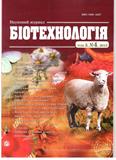ISSN 1995-5537

"Biotechnology" journal Vol. 3, No. 4, 2010
Р. 55-61, Bibliography 14, Russian.
Universal Decimal classification: 577.153
О. М. Gromozova, S. I. Voychuk, T. L. Kachur, V. F. Gorchev, S. A. Karakhim
Institute of Microbiology and Virology of National Academy of Sciences of Ukraine, Kyiv;
Palladian Institute of Biochemistry of Ukrainian of National Academy of Sciences, Kyiv
The methods of luminescence and confocal laser scanning microscopy have been shown to allow detection not only polyphosphate containing granules in various sites of a cell, but to investigate their structure as well. They can be used for monitoring of biology phosphorus removal. A morphological identity of volutin granules of representatives of different groups of microorganisms was shown on an example of yeast Saccharomyces cerevisiae, mycelial fungi Fusarium and diatom alga Frustulia saxonica Rabenhorst. Though their sizes vary over a wide range from 0.2–0.5 mkm up to 4–5 mkm, in all cases the received three-dimensional images of the investigated granules denote on presence of the elongated «cigar-like» components. They can be as single grains or form congestions of the complex geometrical form.
Key words: polyphosphate-accumulating microorganisms, volutin granules, confocal laser scanning microscopy, luminescence microscopy, yeast, micromycetes, diatomalga.
© Palladin Institute of Biochemistry of National Academy of Sciences of Ukraine, 2008

